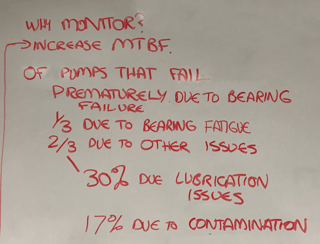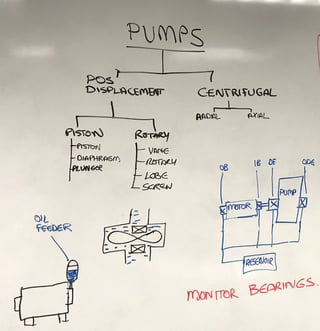 Pumps are used in industrial and fleet applications to move liquids and gases. Most pumps used in industrial applications are either positive displacement or centrifugal. In both cases bearings are the component that must be lubricated and monitored. Rotary positive displacement pumps have gears, screws, lobes or vanes which are also lubricated, usually by the fluid they are pumping, whether it is a lubricant or an oil /air mix.
Pumps are used in industrial and fleet applications to move liquids and gases. Most pumps used in industrial applications are either positive displacement or centrifugal. In both cases bearings are the component that must be lubricated and monitored. Rotary positive displacement pumps have gears, screws, lobes or vanes which are also lubricated, usually by the fluid they are pumping, whether it is a lubricant or an oil /air mix.
 Bearing failures are the second leading cause of pump repairs, after mechanical seals. Pump maintenance using oil analysis focuses mostly on the bearings and bearing life. Most pump bearings do not reach their theoretical (L10) fatigue life. Two-thirds of all rolling element bearings in service, which had to be replaced, failed prematurely. Only one-third of bearings fail due to fatigue spalling (L10 Life). Of the two-thirds that failed prematurely the break down is as follows:
Bearing failures are the second leading cause of pump repairs, after mechanical seals. Pump maintenance using oil analysis focuses mostly on the bearings and bearing life. Most pump bearings do not reach their theoretical (L10) fatigue life. Two-thirds of all rolling element bearings in service, which had to be replaced, failed prematurely. Only one-third of bearings fail due to fatigue spalling (L10 Life). Of the two-thirds that failed prematurely the break down is as follows:
- 30% of bearings fail early due to lubrication problems
- Poor or incorrect lubricant
- Degraded lubricant
- Lack of lubricant
- 17% fail due to contamination entering the bearing. This is a most troublesome factor because contaminants are everywhere.
Typical contaminants are:
- Air
- Water
- Cleanup / process chemicals
- Particulates
 Monitoring pumps with oil analysis is an accepted method for improving the MTBF of the pump.
Monitoring pumps with oil analysis is an accepted method for improving the MTBF of the pump.
Kinematic Viscosity
The resistance of a fluid to flow under gravity. Viscosity is the most important lubricant physical property for pumps. The viscosities of lubricants vary depending on their classification or grade, as well as the degree of oxidation and contamination in service. Oil viscosity is expected to rise over time and use, and loss of viscosity is considered to be more serious than an increase. Viscosity is routinely measured right after an oil change to confirm the right oil was added, as well as on a periodic basis. New technologies make it easy to measure kinematic viscosity- solvent free, low volume systems are available that combine ease of use with data logging ability.
Water Contamination
Water is the most common liquid contaminant in pumps worldwide, and always needs to be monitored. Excessive water in a system destroys a lubricant's ability to separate opposing moving parts, allowing severe wear to occur with resulting high frictional heat. Water contamination should not exceed 0.25 % for most equipment, though centrifugal pumps used in power plants specify much tighter limits such as 500 ppm for boiler feed pump bearings. A number of new technologies exist to detect water contamination in lube oils, and on-site results correlate extremely well with laboratory techniques.
Particle Counting
Particle counting measures the cleanliness of a fluid, and is a critical test for centrifugal pumps, where sleeve bearing or rolling element bearings are being monitored. For positive displacement pumps it helps to determine if ingression or wear is occurring on other moving parts in addition to bearings. Gear and vane pumps have very tight tolerances, and are susceptible to jamming if the oil isn't filtered properly. When particle counts are elevated, it is important to understand the cause. Newer technologies such as LaserNet Fines not only count particles and report to ISO 4406 or SAE AS 4059, they also provide more detail about particle morphology to help the user understand where the particles are coming from. Particle imaging enables maintenance teams to immediately see sand/dirt particles and also the level of ferrous debris that is contributing to the count. This level of detail enables smarter work orders to be developed, focusing on eliminating the root cause of the particle.
Total Acid Number
Refers to a titration method designed to indicate the relative acidity in a lubricant. When the TAN value reaches a predetermined level for a given lubricant and application it is often time to change the oil. An abrupt rise in TAN indicates an abnormal operating condition (e.g. overheating) that requires investigation.
Elemental Spectroscopy
Elemental spectroscopy is atechnique for detecting and quantifying elements in a used oil resulting from wear, contamination and additives. The oil sample is energized to make each element emit or absorb a quantifiable amount of energy, which indicates the elements concentration in the oil. The results reflect the concentration of all dissolved metals (from additive packages) and particulates. This test is the backbone for all on-site and off-site oil analysis, as it provides information on machine, contamination and wear condition relatively quickly and accurately.
For pumps, bearing wear from nonferrous roller components can be detected using elemental spectroscopy.
Infrared spectroscopy
Infrared Spectroscopy is a great technique for detecting organic contaminants, water and oil degradation products in a used oil sample. These are detected by analyzing the infrared spectrum of a used oil and searching for absorbtion at specific peaks that correspond to the presence of various components. The concentration of these components is proportional to the amount of light absorbed at the wavelenght of interest.
Oxidation is a measure of the degradation byproducts in the oil. If oxidation becomes severe, the lubricant will corrode critical pump surfaces. The greater the "oxidation number", the more oxidation is present.
WDA (Wear Debris Analysis/(Analytical Ferrography)
WDA describes either a patch or an analytical technique which separates magnetic wear particles from the oil and deposits them on a glass slide known as a ferrogram. Microscopic examination of the slide or patch permits characterization of the wear mode and probable sources of wear in the machine. This technique is known as analytical ferrography. It is an excellent indicator of abnormal ferrous and non ferrous wear, however it is usually only carried out by a trained analyst.

Recommended oil analysis test packages for Pumps


